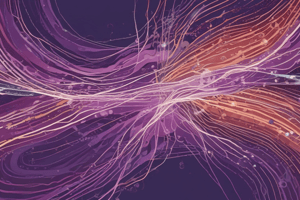Podcast
Questions and Answers
What is the primary purpose of a neurological examination in children presenting with epilepsy?
What is the primary purpose of a neurological examination in children presenting with epilepsy?
- To detect neurocutaneous disorders and dysmorphic features (correct)
- To determine the economic impact of epilepsy
- To assess the patient's immune response
- To identify specific viral infections
Which statement accurately describes the function of the EEG in epilepsy diagnosis?
Which statement accurately describes the function of the EEG in epilepsy diagnosis?
- It helps confirm the presence of epilepsy and classify it (correct)
- It serves as a screening tool for all neurological disorders
- It is used to measure blood flow in the brain
- It primarily assesses the patient's cognitive function
What characteristic of epileptiform discharges distinguishes them from normal EEG activity?
What characteristic of epileptiform discharges distinguishes them from normal EEG activity?
- They are of low voltage
- They are typically of high voltage compared to surrounding activity (correct)
- They exhibit regular patterns
- They occur exclusively during sleep
In a referential EEG recording, what do the two inputs in each channel represent?
In a referential EEG recording, what do the two inputs in each channel represent?
What is a significant feature of digital EEG recordings?
What is a significant feature of digital EEG recordings?
Why is careful examination of the skin particularly important in children with epilepsy?
Why is careful examination of the skin particularly important in children with epilepsy?
What does the term 'lateralization of the epileptogenic zone' refer to?
What does the term 'lateralization of the epileptogenic zone' refer to?
What is the ideal condition for the reference electrode in EEG recordings?
What is the ideal condition for the reference electrode in EEG recordings?
Flashcards are hidden until you start studying
Study Notes
Examination of Epilepsies
- Examination priorities change with patient age; in children, skin examination is key for identifying neurocutaneous disorders linked to epilepsy.
- Dysmorphic features may indicate underlying chromosomal abnormalities, aiding in diagnosis.
- Neurological exams may uncover mental status changes or motor reflex asymmetries, important for locating the epileptogenic zone in focal epilepsy.
- A significant number of patients often present with a normal neurological examination.
Electroencephalography (EEG)
- EEG graphically represents voltage changes over time, with each channel capturing potential differences between two scalp electrode positions.
- Referential recordings feature one electrode as active and another as neutral; however, the neutral reference often lacks true neutrality.
- Bipolar recordings show potential differences between adjacent electrodes in a defined montage.
- Digital EEG recordings now standardize EEG practices, allowing for montage reformatting and the use of filters to enhance interictal and ictal EEG activity visualization.
- When seizure history aligns with epilepsy, EEG serves as the primary test for confirmation, classification (focal or generalized), and sometimes, specific syndrome identification.
- Criteria for classifying discharges as epileptiform include higher voltage compared to surrounding EEG activity, indicating the presence of seizure activity.
Studying That Suits You
Use AI to generate personalized quizzes and flashcards to suit your learning preferences.




